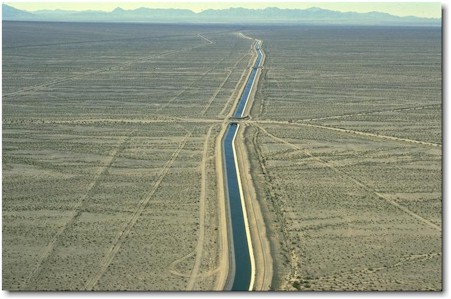In today’s news media, California gets much of the attention when it comes to the negative and lingering effects of the drought. While other areas do not get nearly as much media attention, drought is affecting vast swaths of the Western United States. As you can see from the most recent US Drought Monitor map below, large areas of Nevada, Oregon, Arizona, Idaho, Washington and Utah face drought conditions. Currently, 76.07% of the Western United States is experiencing some form of drought. The region has also experienced consistent drought conditions for the last year. Indeed, a year ago, 69.19% of the Western United States also was in a drought. These states have to make due with limited water supplies and a range of new regulations designed to conserve as much water as possible through the drought. Continue reading
Water Exporter Riverside Sues State over 28% Cutback
In California, drought has been redefined as when your city has surplus water it already sells to alleviate shortages of other water suppliers that doesn’t count towards its state-mandated water cutback. Even water suppliers that are water independent and export water to other water districts to alleviate drought are being tagged with as much as 28 percent mandated water cutbacks.
One such city is Riverside, which has sued the California Water Resources Control Board over its 28 percent reduction mandate on the basis that it is “water independent” and its groundwater should be counted toward meeting the requirements for only a 4 percent water curtailment. Statewide the Water Board’s goal is to cut back urban water usage by an average of 25 percent. But the Water Board has mandated a certain percentage of water reduction, from 4 to 36 percent, for each city based on gallons of water used per person per day.

Thinking About the Availability of Wheeling Capacity on the Colorado River Aqueduct
With the implementation of the Quantification Settlement Agreement in 2003, the amount of Colorado River water available to the Metropolitan Water District of Southern California has been less than the capacity of the Colorado River Aqueduct (“CRA”). For example, the Bureau of Reclamation currently forecasts that Metropolitan’s use of Colorado River water will be 861,616 AF in 2015 http://www.usbr.gov/lc/region/g4000/hourly/forecast15.pdf. This is 438,834 AF less than the historical maximum annual amount of 1.3 million AF of Colorado River water conveyed through the CRA. Continue reading
Bottled Water and the Drought: The Center of Debate over Water Policy in Oregon and California
The drought in the western United States is currently at its worst across much of California and Nevada, where exceptional drought covers 46.73% and 18.38% of each state respectively according to the US Drought Monitor. Parts of Utah, Idaho and Oregon are also experiencing extreme drought. In Oregon’s case, the drought unfortunately is only getting worse. At the start of the calendar year, 49.29% of the state was under severe drought conditions or worse. Currently, 68.48% of the state is under these conditions. The drought has prompted Oregon Governor Kate Brown to declare drought emergencies in 15 counties. The drought declaration gives the affected counties eligibility to receive Federal funding and assistance to combat the lingering effects of the drought. In relation to the drought declaration she said, “The majority of our state is parched due to the warm winter and lack of snow. As we move into summer, many areas of the state are going to dry out quickly, likely leading to a difficult fire season as well as water shortages.” Continue reading
